4/1/2018
Forthcoming Foes
Jennifer Zurko
Spotted lanternfly: A new headache
If you don’t live in the Mid-Atlantic area of the U.S., you’ve probably never heard of spotted lanternfly. But Dr. Jill Calabro, Research & Science Programs Director for AmericanHort, said it’s still worth mentioning, even though it’s only a regional problem at this point.
Although it only affects trees, the types that are infected are numerous, which means it could not only become a major headache for those who grow and sell nursery plants, but also landscapers whose clients have these trees in their yards and garden center retailers, since some of their customers may come in looking for treatment solutions.
“Over 70 plant hosts have been identified, including tree-of-heaven, which is horribly invasive throughout the Mid-Atlantic (and perhaps beyond),” she said, which means it could spread quickly. “This could become a significant, new pest.”
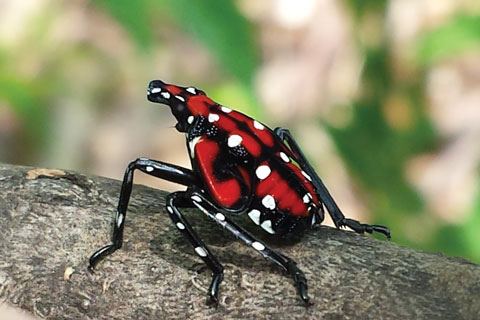 Pictured: An immature spotted lanternfly is black with white spots and develops red patches as it grows. Photo credit: Lawrence Barringer, Pennsylvania Department of Agriculture
Pictured: An immature spotted lanternfly is black with white spots and develops red patches as it grows. Photo credit: Lawrence Barringer, Pennsylvania Department of Agriculture
Stanton Gill, Extension Specialist in IPM for Greenhouses and Nursery at the Central Maryland Research & Education center, said that spotted lanternfly has been a topic of discussion for the last year or so, especially among entomologists. Now, the discussions have heated up and resulted in a quarantine in the state of Pennsylvania.
So far, there aren’t any problems with herbaceous annuals or perennials, said Stanton, but “it will be a big deal to grape growers for wine and hops growers for beer. The adults and nymphs inject a toxin that is similar to the chemical found in blister beetles. A real downer for beer and wine lovers, I would think.”
Although there’s still not a lot we don’t know about spotted lanternfly—especially how to combat it and stop it from spreading—the Penn State University Extension Office released information on what to do when you see it.
Background
The spotted lanternfly (Lycorma delicatula) is native to China and was first detected in Pennsylvania in September 2014. Lawrence Barringer, Entomologist for the Pennsylvania Department of Agriculture who’s been studying the insect extensively, said that they’re not exactly sure how it came over here to the U.S.
“Our best guess is that they came over as egg masses on stone shipments,” he said. “Prior to knowing that spotted lanternfly is a threat, mud-like smears on stone were not a high priority for port inspections. Even to trained surveyors here, they are remarkably cryptic.”
It feeds on a wide range of fruit, ornamental and woody trees, with tree-of-heaven being one of the preferred hosts. Spotted lanternflies are invasive and can be spread long distances by people who move infested material or items containing egg masses.
The adult is approximately 1-in. long and ½-in. wide at rest. The forewing is grey with black spots and the wings tips are reticulated black blocks outlined in gray. The hind wings have contrasting patches of red and black with a white band. The legs and head are black; the abdomen is yellow with broad black bands. Immature stages are black with white spots and develop red patches as they grow.
Signs & symptoms
• Plants that ooze or weep and have a fermented odor
• Buildup of sticky fluid (honeydew) on plants and on the ground underneath infested plants
• Sooty mold on infested plants
Inspect trees and plants for signs of this pest, particularly at dusk and at night when the insects tend to gather in large groups on the trunks or stems of plants. They can also be found in bricks, stone and other smooth surfaces where they lay their eggs.
What to do
If you find a spotted lanternfly in a municipality where it’s not known to exist, you should try to capture it and put it into a vial filled with alcohol to kill and preserve it, or at least take a good picture of it. Report it to the Pennsylvania Department of Agriculture (PDA) by emailing badbug@pa.gov or call the Invasive Species Hotline at (866) 253-7189. Your discovery could add additional municipalities to the quarantined area.
If you find spotted lanternfly in a municipality where it’s known to exist, you should try to kill it. Each female lays up to 100 eggs or more in the fall, so by destroying even one female, you’re reducing the potential population for the future.
Soft rot on bulbs
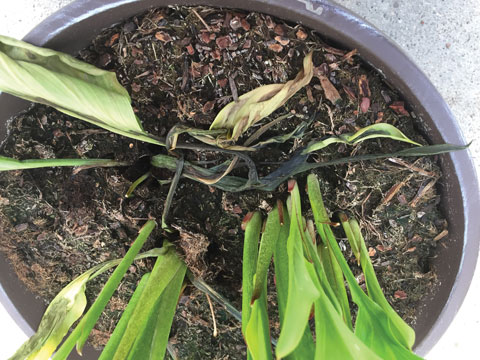 For something a little different—but that’s still important for you to pay attention to—is soft rot caused by Erwinia spp. (=renamed Pectobacterium), which can affect a wide range of plants, from tropical foliage plants to bedding plants to bulbs. Disease expert Ann Chase gave us the lowdown:
For something a little different—but that’s still important for you to pay attention to—is soft rot caused by Erwinia spp. (=renamed Pectobacterium), which can affect a wide range of plants, from tropical foliage plants to bedding plants to bulbs. Disease expert Ann Chase gave us the lowdown:
On calla lilies, the damage tends to start as collapse of leaves at the base. This mushy stem rot starts at the soil line and rapidly leads to complete meltdown. If roots are checked, they show a clear collapse that can be confused with Pythium that’s also common on callas, and eventually, a mushy bulb collapse with a fishy odor and slimy texture occurs.
Pictured: Soft rot bulb damage tends to start as collapse of leaves at the base. Eventually, you get a mushy bulb collapse with a fishy odor and slimy texture.
Overhead irrigation, excessive irrigation, use of too much fertilizer (especially phosphorus) and warm-to-hot temperatures each promote soft rot on callas. Several studies showed that wounding didn’t increase soft rot incidence. Callas grown using a sawdust medium with plants under shadecloth had fewer soft-rotted plants and tubers than callas grown in soil.
A variety of treatments have been researched across the globe. Under greenhouse conditions, pre-plant application of Champ 2 or Phyton-27 didn’t reduce the number of diseased plants compared with the controls. In contrast, post-planting applications of Champ 2 or fixed copper were effective in reducing soft rot, however, these two compounds also reduced overall plant growth.
Three products were compared as pre-planting dips with copper-based compounds (Phyton 27 and Champ) providing better control of bacterial soft rot than Physan-20. In separate studies, a 30-minute streptomycin dip at 200 ppm gave better control than a quaternary ammonium dip. Dipping tubers before planting in an aqueous solution of 0.08% copper hydroxide, 0.12% thiram, plus 0.03% benomyl (no longer available in the U.S.) reduced plant and tuber losses from bacterial soft rot.
These studies have demonstrated that effective control of calla soft rot can be achieved using pre-planting dips in copper or streptomycin sulfate and post-planting drenches with coppers.
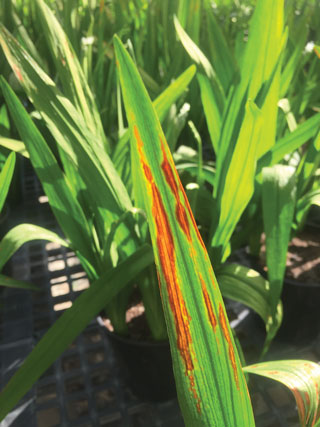
Another bulb disease
Ann also told us about Freesia mosaic potyvirus (freMV), which she saw for the first time about 15 years ago in a cut flower operation.
“The symptoms looked more like a toxicity, but they were a virus and were confirmed by testing,” she explained. “Unfortunately, it is most commonly spread through distribution of virus- infected bulbs.”
According to Ann, this virus has been studied a little over the past 40 years or so and has been found all over the world. It appears that, many times, more than one virus is present, and as with some other diseases, symptoms change based on which ones are present.
Symptoms range from slight leaf yellowing to mosaic patterns in leaves between veins (like brown, rusty streaks shown in the image). The virus spreads easily by infected bulbs, but is also shown to be soilborne (obviously, not an issue in container crops) and is mechanically transmitted and moved by aphids like other potyviruses. As with other viruses, the only solution is use of pathogen-free bulbs if at all possible, rigorous control of aphids, and scouting and dumping of symptomatic plants.
Pictured: Freesia mosaic potyvirus symptoms range from slight leaf yellowing to mosaic patterns in leaves between veins, like these brown, rusty streaks.
Western flower thrips
“Thrips is always a big deal in the South since they usually start blowing in from the outside,” said JC Chong, Associate Professor of Entomology at Clemson University and editor of our PestTalks e-newsletter. “It is generally presumed that western flower thrips are resistant to many insecticides, but few, if any, published studies have clearly documented the level of resistance in greenhouse floricultural production.”
JC said that resistance may be greater in northern greenhouses because the thrips are “trapped” inside those greenhouses and have greater exposure to insecticides. In the South, where more of the side vents are open when the weather is mild, the thrips will move in from the outside. This movement into the greenhouse also brings in field thrips populations that aren’t resistant to insecticides, diluting the risk of insecticide resistance development, in a way.
“Many, but not most, insecticides are at risk of facing resistance,” he said.
Background
Adult western flower thrips are approximately 1- to 2-mm in length and generally yellowish-brown in color. The life cycle consists of five stages: egg, larval, pre-pupal, pupal and adult. Female adult western flower thrips live up to 30 days and lay two to 10 eggs per day. At 68F (20C), development from egg to adult takes approximately 19 days. At 77F (25C), it takes 13 days.
The eggs are inserted into soft plant tissues, including flowers, leaves, stems and fruit. The larval stage consists of 2 instars that feed and develop on the leaves, flowers and fruit. The pre-pupal and pupal stages often complete their development on the ground or growing medium, but pupation can also take place on the plant. The pupa is a non-feeding stage during which the wings and other adult structures form.
The adults are weak fliers, usually taking short flights from leaf to leaf or plant to plant. Nevertheless, they disperse rapidly throughout the greenhouse. Adult thrips can be transported on wind currents and will enter the greenhouse through vents and doorways. At all stages, they may be dispersed on workers’ clothing and on infested plants, growing media or farm implements.
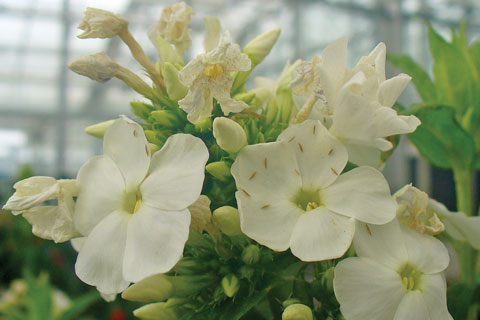
Damage
The adult and larval stages feed by piercing the plant surface with their mouthparts and sucking the contents of plant cells. This causes white or brown spots on the leaves where the plant cells have been destroyed. These spots are also speckled with dark fecal droppings from the thrips.
Pictured: Western flower thrips on Phlox paniculata.
Western flower thrips have a host range of hundreds of plant species, including many major commercial floriculture crops. Damage includes feeding scars and leaf distortion. Thrips are particularly attracted to flowers, where they cause damage, such as streaking and scarring of petals, distortion of flowers and flower buds, and incomplete petal expansion. Western flower thrips are the most important vector of a group of viruses called tospoviruses (read more on tospoviruses on page 58).
Monitoring
Monitoring the population levels of western flower thrips is critical for successful pest management. In vegetable crops, monitoring should begin during propagation and continue after transplanting. In floriculture crops, thrips can be present at damaging levels year-round, although populations are usually smaller during winter.
Commercially available blue or yellow sticky traps can be used to monitor the population densities of adult thrips. Blue traps are more attractive to western flower thrips, although yellow traps are more attractive to other pests, such as whiteflies and aphids. Your choice depends on how many pests you need to monitor, the susceptibility of the crop to thrips and/or tospoviruses and your need to detect thrips populations at low levels.
When setting up a monitoring program, use one trap per 100 to 200 square meters. The exact number will depend on the layout of the greenhouse. A large open range will require a lower total density of cards than a greenhouse made up of several smaller areas.
Place the sticky cards in a grid pattern throughout the greenhouse. Check the traps weekly and record the average number of thrips per trap. Be aware that this isn’t an absolute measure of the population; rather, it measures increases and decreases in thrips numbers throughout the year. As you become more aware of how the numbers on sticky cards relate to the population in the crop, you can use the monitoring data to help you make pest management decisions.
In greenhouse ornamentals, visually inspecting simple flowers, such as impatiens, can provide good estimates of thrips numbers in the crop. However, in more complex flowers, visual counts can be less reliable.
Biological control
As JC mentioned above, thrips are difficult to control with insecticides and the risk of insecticide resistance development is high. As a result, biological control is now the primary strategy in controlling thrips in many greenhouses.
Biological control agents include predatory mites such as:
• Neoseiulus (= Amblyseius) cucumeris
• Amblyseius swirskii
• Iphesius (= Amblyseius) degenerans
• Stratiolaelaps scimitus (= Hypoaspis miles)
• Gaeolaelaps gillespiei
• Gaeolaelaps aculeifer (= Hypoaspis aculeifer)
• Minute pirate bugs (Orius insidiosus)
• Nematodes (Steinernema feltiae)
• The fungal insect pathogen Beauveria bassiana
• Entomopathogenic fungi Metarhizium anisopliae for thrips pupae control
• Isaria fumosorosea, for all stages, like B. bassiana
Chemical control
Chemical control of western flower thrips can be difficult. They’re resistant to many pesticides and feed deep within the flower head or on developing leaves. This makes them a difficult target for insecticides, so thorough coverage is essential. If you use pesticides to control thrips, follow these general guidelines:
• Begin applications early, before the thrips population grows too large. Thrips are more easily managed when population levels are low.
• Although it’s important to rotate chemical classes, use only one chemical class for the duration of the thrips' life cycle. This generally means using a different class every two to three weeks, depending on the time of year.
• Apply pesticides in early morning or late afternoon, when flight activity of thrips is at a peak. This increases exposure of the thrips to the pesticides.
Leaf spot on begonias
Margery Daughtrey, Senior Extension Associate for Cornell University’s Horticultural Research & Extension Center on Long Island, joked that “begonias are the darlings of the bedding plant world—you never have to worry about them getting impatiens downy mildew!”
But that doesn’t mean you don’t have to worry about disease issues. There are some common diseases on begonias, with the most notable being Botrytis blight, Impatiens necrotic spot virus and Tomato spotted wilt virus.
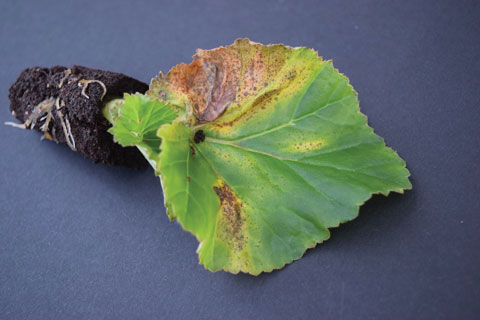 Pictured: The most distinctive symptoms of bacterial bli ght are shownhere: brown wedges surrounded by yellowing and freckles.
Pictured: The most distinctive symptoms of bacterial bli ght are shownhere: brown wedges surrounded by yellowing and freckles.
This year, however, Margery said that one of the more occasional diseases of begonias might be more widespread than usual.
“The begonia supply chain had some problems a few months ago with Xanthomonas axonopodis pv. begoniae, which is a long Latin name for the agent of a bacterial leaf spot and wilt disease,” she explained. “If the name sounds familiar it’s because this bacterial disease is analogous to the bacterial blight disease on geranium.”
Margery said that we know more about the geranium disease because geraniums have been an important crop for so long, but now that begonias are on the rise, the bacterial disease that affects them should be watched for carefully.
The Xanthomonas diseases of geranium and begonia are distinctly different: the bacteria on begonia cannot affect geraniums and vice versa. The pathogens are even considered different species, but they both need to be taken seriously because they cause leaf spotting, that in some cases, will progress to stem death and wilt of their respective hosts.
The bacterial leaf spot and wilt of begonia can be latent for weeks before you see any indications—the bacteria need warm temperatures to multiply and cause symptoms, so watch your crop throughout this season to avoid large-scale unwelcome surprises. Rogueing out the plants that show the characteristic spotting is your best defense against the disease. Protective treatments with copper fungicides and Bacillus subtilis biocontrols can help to keep the healthy plants healthy, but only if you keep the inoculum pressure down by removing the diseased plants as they become apparent.
The bacteria will invade through wounds (such as the cracks that happen during shipping and handling) or natural openings, like the stomates. Most of the time, you see infections at the hydathodes, which are natural openings used for water regulation that occur along the perimeter of the leaf. When bacteria enter at the leaf edge, they will form a wedge-shaped, brown leaf spot. There is also usually yellowing around the spot and some dark freckling within the yellow zone.
Margery warned not to overreact to discoloration at the leaf edge that’s due to a physically broken vein or to brown spots due to a Botrytis attack, which tend to look zonate and typically show neither yellowing nor freckles.
Although virtually all begonias have some susceptibility to the bacteria, in practice it doesn’t trouble Begonia semperflorens, the standard bedding plant.
“When we have purposefully inoculated plants, Rieger begonias and Rex begonias have been quite susceptible,” said Margery. “Begonia boliviensis has shown the most extreme sensitivity, with the disease becoming systemic in branches and causing them to wilt.”
Also, beware of the ability of the bacteria to move from one kind of begonia to another in your greenhouse; some of the less-sensitive types can have inconspicuous spots and be a reservoir of inoculum that can bother other begonias later on. Spread is usually by splashing or handling. GT